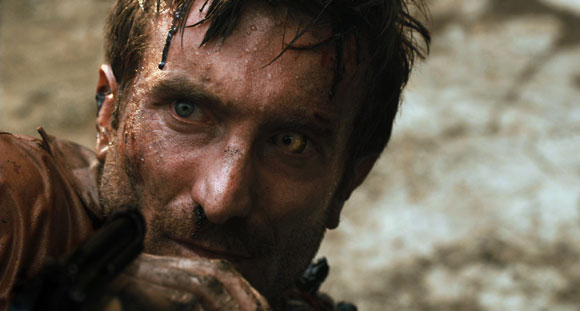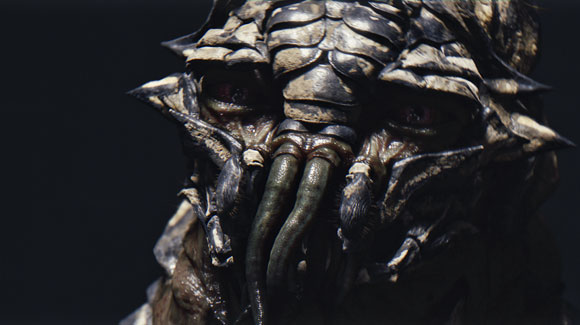District 9

Many comments have floated around that first-time writer/director Neill Blomkamp’s District 9 is a ripoff of Graham Baker’s 1988 science fiction, Alien Nation. It’s true that there are alien refugees, a prejudiced enforcement agent, a round mothership, and a parable about racism. That is, however, the extent of the depth of similarity between the two. Alien Nation is really a buddy cop story much in the style of the Lethal Weapon series. District 9 couldn’t be further from that.
The film begins in a documentary style and follows the story of Wikus van der Merwe (Sharlto Copley), who has been charged with the resettlement of 1.8 million alien refugees who first arrived Johannesburg, South Africa, in 1982. There is no standard introduction to the protagonist, but in the style of a good documentary, there unfolds a story about Wikus and the incident at District 9. Upon their arrival, the aliens—arthropod-like creatures—are found in their spacecraft looking gaunt and helpless. The then Apartheid government of South Africa decides to quarantine them to a shanty village called District 9.
Mr. Copley, a first-time feature actor who co-produced Alive in Joburg, the conscience-itching 6.5 minute short film upon which District 9 expanded, deftly portrays the bumbling ignoramus. In early documentary footage, Wikus possesses the naivete of a typical government desk jockey. Regarded by peers and family as sweet, but somewhat incompetent, it’s puzzling that he’s put in charge of a resettlement project headed by MNU, a conglomerate which immediately evokes images of Blackwater. However, program director Piet Smit (South African television actor, Louis Minnaar, giving us a despicable corporate mogul very reminiscent of Charles Widmore in ABC’s “Lost”) happens to be Wikus’ father-in-law. We get a sense of Wikus’ ignorance as he and others refer to the aliens as “prawns”—a derisive slur just as “kaffir” (“heathen” in Afrikaans) was used by Afrikaners to describe blacks.

Early marketing had painted the aliens as an ominous force, and also played on UFO conspiracy theories by claiming the film was “based on true events.” The aliens more or less exhausted their resources and, most importantly, a biological fuel that makes it possible for their technology to function. District 9 is in fact based on real events having, however, absolutely nothing to do with aliens. To those who know the three-decade long history of the NP-led Apartheid government in South Africa which ended in 1994, the parallel is immediately clear. Wikus is at the center of a narrative based on the events of District Six, Cape Town, South Africa, and the resettlement of 60,000 of its inhabitants. But rather than serve us a lumbering parable entirely about racism, the story quickly narrows its focus on the man responsible for their resettlement to District 10, Wikus (Sharlto Copley in a remarkable debut performance).
In his desperation after being infected by a device that could possibly be a biological weapon—the aliens’ plan not made immediately evident—Wikus, ironically, becomes a refugee. He comes to rely on the aid of an alien referred to as Christopher Johnson. I suspect that this, too, may be a nod to the more whimsical Alien Nation in which the “Newcomers” were allowed to choose human names for legal purposes as well as easy pronunciation for humans. There certainly are assimilation references therein, as well.
While the film does descend into some action sequences in the latter half, one cannot help but feel a degree of satisfaction given all that Wikus and Christopher have been through. But what impresses me is that Mr. Blomkamp, a former visual effects artist (whose 2005 CG demo “Tetra Vaal” is clearly set against the backdrop of Soweto), uses the CG not to simply show us explosions and spaceships, but also to articulate emotion in Christopher’s eyes. It is perhaps a stylistic choice to give the aliens human irises, so that we might relate better to their expressiveness.
I do wonder, though, if Mr. Blomkamp could have pulled off using entirely alien eyes to convey the same sense of emotion once he’s endeared us to the characters. That would be a fantastic feat of storytelling. But endear us, he does, even if only in a novice manner—Christopher’s child, whom he simply refers to as Little One, tugs quietly at the heartstrings as he, having likely been born on Earth or in transit, yearns to see their home planet. On the subject of borrowing from other films, how about the cute, if prepsterous, 1980’s film Short Circuit. I swear there’s a bit of Johnny Five, for those who remember, in Christopher’s varied facial expressions—reliant primarily on the eyes which occupy the majority of the face, above the grasshopper-like mandibular structures. But is that a bad thing? It’s certainly less noticeable than the references to Cronenberg et. al.
The film raises other questions, e.g. How does the ship remain afloat in our atmosphere if unpowered? Being worker drones, are there alien separatists who refuse to return home? Why do they not use their weaponry to fight back? Though I think this last question may be resolved by the fact that Christopher, and some others, appear to be only angry that they are treated like third-class citizens, otherwise reluctant to resort to all-out violence as means to an end—also lacking a directive from a central intelligence, given that they are worker drones. Even that, however, is a theme left relatively unexplored. And what about the obsession with cat food? Believe me, it doesn’t make a lot of sense even in context. I feel there was a subplot or two left on the cutting room floor. But these are really minor quibbles, in my humble opinion, largely because the film preoccupies us in suspense over the evolving interdependence of the compelling protagonists, Wikus and Christopher. The story drags in some places, and could have easily been cut by ten minutes. However, I do think that it remains one of the best science fictions in recent years, vectoring the genre back toward its original scope—meaningful social commentary. I simply hope Mr. Blomkamp will develop a more unique story of greater depth, with a fleshed-out ensemble of characters, in his sophomore effort. He certainly demonstrates the capacity.
What is, to me, most interesting about this story is how the aliens test our own prejudices. If the aliens had been mammalian in appearance, I suspect our empathy would not be tested to its limits. Instead we are given insect-like creatures who do not understand our culture, consequently destroying our property like locusts, and have the misfortune of making contact with an Apartheid regime. The film persuades us to look beneath the aliens’ chitinous exterior, and slowly eats at us as the images of racism, subjugation and internment become familiar and prod our conscience. Isn’t it funny how when we are all given a common outsider, our prejudices come out. Sure enough, even the emancipated blacks of Soweto want the aliens to go home. How quickly we forget.
See the exclusive interview with writer/director Neill Blomkamp and actor Sharlto Copley here.
 District 9 • Dolby® Digital surround sound in select theatres • Aspect Ratio: 1.85:1 • Running Time: 112 Minutes • MPAA Rating: R for bloody violence and pervasive language. • Distributed by TriStar Pictures
District 9 • Dolby® Digital surround sound in select theatres • Aspect Ratio: 1.85:1 • Running Time: 112 Minutes • MPAA Rating: R for bloody violence and pervasive language. • Distributed by TriStar Pictures